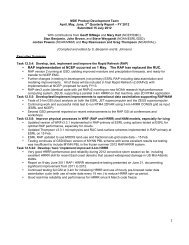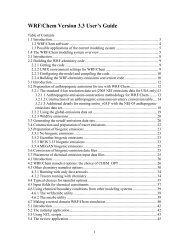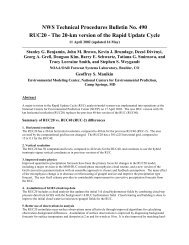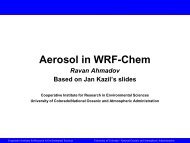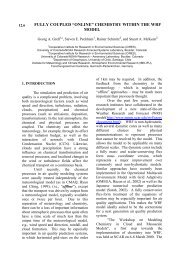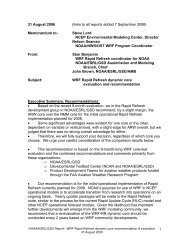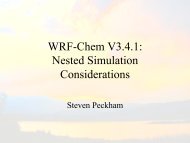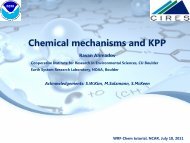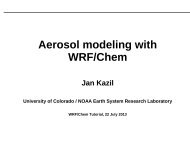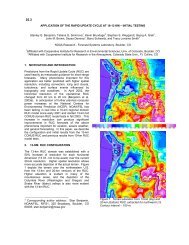MODEL DEVELOPMENT AND ENHANCEMENT PDT - RUC - NOAA
MODEL DEVELOPMENT AND ENHANCEMENT PDT - RUC - NOAA
MODEL DEVELOPMENT AND ENHANCEMENT PDT - RUC - NOAA
Create successful ePaper yourself
Turn your PDF publications into a flip-book with our unique Google optimized e-Paper software.
<strong>MODEL</strong> <strong>DEVELOPMENT</strong> <strong>AND</strong> <strong>ENHANCEMENT</strong>PRODUCT <strong>DEVELOPMENT</strong> TEAMMonthly Report for February 2007Submitted 15 March 2007With contributions from Geoff DiMego and Mary Hart (NCEP/EMC);Stan Benjamin, John Brown, Steve Weygandt (<strong>NOAA</strong>/ESRL/GSD);Jordan Powers, Roy Rasmussen, and Bill Hall (NCAR);Ming Xue (OU/CAPS)Compiled and edited by Stan Benjamin and Holly PalmExecutive SummaryTask 07.5.1: Infrastructure support related to operational running of the <strong>RUC</strong> and NorthAmerican Mesoscale (NAM) operational modeling systems.• Summer <strong>RUC</strong> change package -- <strong>RUC</strong> analysis (including mesonet winds, radar reflectivity),model changes (RRTM longwave radiation and updated convection), and postprocessingenhancements (forecast radar reflectivity and tropopause theta) nearly ready to go to NCEP.Task 07.5.4: Develop, test, and implement Rapid Refresh configuration of the WRF modelingsystem.• Real-time WRF-RR 12-h cycle now running on full North American domain and CONUSdomain (GSD)Task 07.5.5: Develop, test, and implement improvements to the operational WRF 3DVARs forRapid Refresh and North American Mesoscale runs.• Good progress toward option to derive ensemble-based background error covariances for use inGSI (NCEP)• Work continues on merging GSD and ARPS cloud/hydrometeor analyses and understandingsensitivity to microphysics schemeTask 07.5.6: Develop, test, and evaluate the performance of the nonhydrostatic WRF modelingSystem.• Progress toward correcting interactions between boundary-layer schemes and FerriermicrophysicsTask 07.5.8: Improve model physics for aviation forecasts• RRTM longwave radiation implemented in development <strong>RUC</strong> with successful results forimproving nighttime near-surface forecasts in warm and cold seasons. RRTM will now be includedin the <strong>RUC</strong> summer change package.07.5.15: Develop improved methods of cloud and moisture analysis for use in the WRF ModelingSystem.• Real-time cycled tests of radar-based latent heat nudging in <strong>RUC</strong> diabatic digital filterinitialization substantially improve 0-6 h precipitation forecasts.• Retrospective cycled tests of combined <strong>RUC</strong>/ARPS cloud analysis (assimilating METAR cloudand GOES-cloudtop data) within GSI-WRF framework.1
Detailed report – MDE – February 2007Task 07.5.1:Infrastructure Support Related to Operational Running of the <strong>RUC</strong> and North AmericanMesoscale (NAM) SystemsNCEPDennis Keyser reports that Cooperative Agency Profiler (CAP) and RASS data are not yet available through analternate ERSL MADIS feed. A new version of the BUFR archive library was implemented on 6 February. GOES-11 layer precipitable water retrievals and GOES-11 cloud-top pressure data were made available to the <strong>RUC</strong>assimilation on 6 February. GOES-12 satellite-derived wind quality was degraded from 20-21 February due toproblems in the image calibration resulting from the activation of an anti-ice heater on the satellite. Three newsubproviders (TELLURIDES, ABASINSA and ASPENSKICO) were added to the Colorado Avalanche InformationCenter (CAIC) mesonet on 14 February.GSDGSD efforts during February have focused mainly on finishing the 2007 change package for the <strong>RUC</strong> prior to itstransfer to NCEP for pre-implementation testing.This <strong>RUC</strong> analysis/model change package (planned for implementation at NCEP by early summer 2007) is currentlyrunning in the 13km dev <strong>RUC</strong> (http://ruc.noaa.gov/pig.cgi?13km_D2 ). A number of additional changes weredeveloped and implemented in the dev<strong>RUC</strong>13 during February, including:• Improved diabatic assimilation of 3-d radar reflectivity via diabatic digital filter initialization.• Addition of column-maximum (i.e., composite) reflectivity product in <strong>RUC</strong> post-processing. This is nowbeing shown in real-time products for both the dev<strong>RUC</strong>13 and the backup <strong>RUC</strong>13 (without radarreflectivity assimilation). Comparison of the radar-reflectivity from dev<strong>RUC</strong>13 and backup <strong>RUC</strong>13products has been especially effective in showing improvements from radar-reflectivity assimilation.• Addition of lightning assimilation to complement the 3-d radar reflectivity assimilation. This addsbuilding of convective areas where lightning strokes are evident and there is no 3-d radar reflectivity data(i.e. over oceans, outside of CONUS).• RRTM longwave radiation package replacing current Dudhia longwave package. This change improvesnighttime forecasts over snow cover (cold-season) and especially a long-standing warm bias in particularlymoist areas (warm season, discussed in the FY06Q4 MDE Report).Previous changes noted in last month’s report and planned for inclusion in the <strong>RUC</strong> change package are shownbelow. These are also running in the dev<strong>RUC</strong>13 at GSD.• Land-surface model changes for improved 2m temperature over snow cover• Change to Grell-Devenyi convective parameterization with improved (decreased) areal coverage for lightconvective precipitation (see 07.5.8 on both topics).• Analysis changes to:o Assimilate mesonet winds using a new “mesonet provider uselist”o Differentiate wind observation error between GPS rawinsondes and non-GPS rawinsondeso Assimilate TAMDAR aircraft observations, if they become available for operational use• Post-processing changes – tropopause theta.In addition to the work on the <strong>RUC</strong> change package, GSD continued to monitor real-time <strong>RUC</strong> performance amongthe operational NCEP version and 4 different experimental GSD versions, using observations from rawinsondes,surface stations, GPS precipitable water, and precipitation. A new verification capability developed by BillMoninger to verify <strong>RUC</strong> (and other) models against rawinsondes at 10-mb intervals instead of the usual mandatorylevelintervals is increasingly utilized for monitoring these different <strong>RUC</strong> versions.INTERFACE WITH OTHER ORGANIZATIONS:Discussion between GSD and NCEP/EMC on upcoming <strong>RUC</strong> changes.Discussions between GSD and <strong>RUC</strong> users in NWS and private sector on <strong>RUC</strong> performance.2
Subtasks07.5.1.1 Maintain hourly <strong>RUC</strong> runs and provide grids of SAV and AIV guidance products.07.5.1.2 Provide vendors with gridded model data via Family of Services (FOS), and the FAA Bulk Weather DataTelecommunications Gateway (FBWDTG).07.5.1.3 Provide full grids from <strong>RUC</strong> runs on NCEP and NWS/OPS servers.07.5.1.4 Maintain access to model verification data.Deliverables07.5.1.E1 1 October 2006 - 30 September 2007 EMC (Rogers, Manikin, Keyser)Perform observation ingest, quality control, and preparation in support of the operational <strong>RUC</strong> runs.CURRENT EFFORTS:OngoingTask 07.5.4: Develop, test, and implement Rapid Refresh configuration of the WRF modeling system.NCEPSteve Lord, director of EMC, has provided documents (Requirements for Maintenance, Enhancement and Transitionto Operations for the Rapid Refresh System in the context of the more general document Requirements forMaintenance, Enhancement and Transition to Operations at the NCEP Environmental Modeling Center) to makeclear the responsibilities and ramifications of the choice of dynamic core for Rapid Refresh.GSDGSD, NCAR and the DTC have reviewed and discussed the “Requirements” documents from NCEP referencedabove and appended to last month’s report, and have drafted a document describing how these requirements wouldbe met by GSD and by NCAR should the ARW be the WRF core used in the initial Rapid Refresh implementation.Responsibilities for GSD regarding maintenance of the Rapid Refresh will be similar to those with the current <strong>RUC</strong>model, but with some responsibility taken also by NCAR, particularly regarding the ARW dynamical core and WRFsoftware infrastructure, if the ARW core is selected.GSD continues to run and verify WRF forecasts initialized with <strong>RUC</strong> over the CONUS domain and cycled with GSIover the RR domain; see details below. Three abstracts dealing with various aspects of work toward the RR (overallreview of RR status, the RR Core Test results, and GSI progress) were submitted to the American MeteorologicalSociety Conference on Weather Analysis and Forecasting/Numerical Weather Prediction scheduled for June at ParkCity UT. An additional paper dealing with diabatic initialization in <strong>RUC</strong> (but having RR application) was alsosubmitted.PLANNED EFFORTS: NCEP will decide on which dynamical core to use for the RR pending outcome of furtherdiscussions with GSD, NCAR and the DTC on the implications of choosing the ARW.PROBLEMS / ISSUES ENCOUNTERED OR ANTICIPATED: None.INTERFACE WITH OTHER ORGANIZATIONS: DTC, NCEP, NCARUPDATES TO SCHEDULE: None.Subtasks07.5.4.1 15 Nov 2006 (original due date), deferred to 15 Jan 2007. COMPLETE as of 10 Dec 2006. (GSD)Begin real-time cycling of RR model with GSI over RR domain at degraded resolution.3
CURRENT WORK: The Rapid-Refresh real-time cycle is ongoing on the IJET supercomputer at ESRL. As of 12February 2007, the new ESRL supercomputer (WJET) became available for use. We have been testing variouscomponents of the RR system on WJET and can now complete the full migration to WJET. There remain, however,some issues with GSI on WJET (setting the endian and compiling the libraries) that Dezso Devenyi, JacquesMiddlecoff and the computer staff are still working to resolve. WJET will provide increased capacity compared toIJET, so once these problems are overcome we can increase the cycle frequency from the current once per12h.PROBLEMS / ISSUES ENCOUNTERED OR ANTICIPATED: Delayed task is now completedINTERFACE WITH OTHER ORGANIZATIONS: NCEPUPDATES TO SCHEDULE: This task for which we previously requested a 2-month delay (from 15 Nov 2006 to15 Jan 2006) is now complete.07.5.4.2 15 Jan 2007 (GSD, DTC) – Completed 5 Jan 2007Build retrospective period capability including different seasons for testing of RR with cycling.CURRENT WORK: The retrospective period chosen is the 10-day period 26 November to 6 December 2006. Thisperiod includes a good variety of weather, including a severe snow/ice storm and severe weather on 29-30November over the Plains and Midwest. This retrospective period is being used for testing impact of TAMDARobservations under non-MD&E funding. It is also available for testing the summer-2007 <strong>RUC</strong> change package, ifneeded.07.5.4.4 15 Nov 2006 (GSD) – Completed 15 Nov 2006.Build graphics and web viewing capability for display of GSD RR real-time and retrospective runs.CURRENT WORK: Web-viewing capability became available for real-time RR cycled runs over the CONUSdomain in October, and is being extended to cover the full North American domain. Images and graphics from thiscan be viewed at http://www-frd.fsl.noaa.gov/mab/wrfruc. Limited objective verification is now available over theCONUS.07.5.4.5 Ongoing (GSD)Further enhancement to WRFpost version for Rapid Refresh application, including modifications to generation of<strong>RUC</strong>-specific fields.CURRENT WORK: Tanya Smirnova has begun modifying the 2.1.2 version of WRFpost used in the RR Core Testlast year so it can be used to generate grib output over the full RR domain.07.5.4.6 Ongoing (GSD, NCAR later)Ongoing evaluation of performance of real-time and retrospective runs of RR system for SAVs, AIVs.07.5.4.7 1 Nov 2006 (GSD) - ongoingStart to solicit input from other <strong>PDT</strong>s and NWS forecasters in Alaska and Puerto Rico regarding how they wish touse the RR and particular forecast challenges for which the RR might be able to provide guidance.CURRENT WORK: Followup contacts have continued. This resulted in an invitation from James Partain, Chief ofthe Alaska Region Scientific Services Division, to discuss RR current development and plans with forecasters andothers at the Great Alaska Weather Modeling Symposium in Fairbanks in March. The RR-relevant outcomes of thisgathering will be discussed in the FY07Q2 report due next month.INTERFACE WITH OTHER ORGANIZATIONS: NWS--Alaska Region4
Deliverables07.5.4.E1 15 October 2006 (GSD)Complete a technical report describing the GSD preliminary real-time and retrospective testing of the WRF RapidRefresh system.Completed 1 September 2006. GSD report was sent to NCEP (see FAA-AWRP MD&E FY06 Q4 report) and madeavailable on the web at http://ruc.fsl.noaa.gov/coretest2 /07.5.4.E2 15 July 2007 (GSD)Deliver report to NCEP on progress with WRF Rapid Refresh code toward FY09 Rapid Refresh implementation.Task 07.5.5: Develop, test, and implement improvements to the operational WRF 3DVARs for RapidRefresh and North American Mesoscale runs.NCEPManuel Pondeca has made substantial progress in adding the option to generate ensemble-based background errorcovariances to the GSI-regional. The input ensemble fields, which can come either from the regional or the globalensemble system, are used to prescribe the local aspect tensor of the anisotropic component of the error covariances.Wan-Shu Wu did some experiments in an attempt to reduce the impact of satellite radiances on moisture analysis.As reported last month, much of the NAM spindown appears to be associated with satellite data with the sign of themoisture increment opposite to that from conventional observations. To reduce the impact, conventionalobservation and background moisture error were decreased, since it was not obvious how to change the error ofsatellite radiances to achieve the same effect. Results of tests were neutral to slightly negative. Sensitivity tests tofine tune the magnitude of divergence damping in the model are also ongoing. While a value of 5x was used in theDecember crisis change bundle, forecasts are degraded when values less than 5x are used and seem optimal at 6x.Dave Parrish reports that the regional strong dynamic constraint was introduced into the NAMX parallel forcomparison against the operational NAM. Results after 3 weeks are mixed. There is general improvement in RMSheight out to 48 hrs, but degradation by 84hrs. RMS winds are neutral to slightly positive over the entire range offorecasts. RMS temperatures are neutral to slightly worse, but always better at 100mb. Threat scores and biasdegrade somewhat for heavy amounts. One consistent result appears to be that 10m winds are improvedsignificantly over the western US, but slightly degraded over the east. The threat scores are also neutral to slightlyimproved for heavy precip over western US, but the opposite over the east. The current strong dynamic constraint isadiabatic. Over the western US, the constraint yields a net improvement because orographic effects are dominantand accurately included in the constraint. However, in the eastern US surface mixing may be dominant overorographic effects. A surface parameterization has been tested with GSI in global mode (M. Rancic), and we plan tointroduce this in the regional mode constraint.GSD07.5.5.1 15 Oct 2006 (GSD and CAPS) – Completed 15 Oct 06Report on testing of <strong>RUC</strong>-like cloud/hydrometeor assimilation (including GOES cloud-top data and METARcloud/visibility/weather data) within WRF-GSI on the full Rapid-Refresh domain.Report was completed 15 October 2006 and is available at http://ruc.noaa.gov/pdf/Verification_<strong>RUC</strong>_ARPS.pdf(Note that this is a 24Mb document; loading is very slow.)Collaborative work continues between GSD and Ming Hu of CAPS to combine the ARPS and <strong>RUC</strong> cloud analysisand further test it within the RR-GSI CONUS environment, using Chris Harrop’s workflow manager. Ming Hufrom CAPS has recently completed an experiment with Lin microphysics scheme and is comparing it withThompson scheme, which will be used for the Rapid Refresh (see details in 07.5.15.E3). As part of the inclusion ofa model-derived forecast reflectivity in the <strong>RUC</strong>, John Brown has created a program to determine the radar5
eflectivity for various values of precipitation hydrometeors based on the Thompson microphysics version used in<strong>RUC</strong>. This program will be used to assist with the comparison of the Lin and Thompson microphysics.07.5.5.2 Based on parallel testing and refinement of the experimental code, deliver a “pre-implementation” versionof WRF-GSI to replace Eta 3DVAR in NAM /NDAS (Oct ’06)07.5.5.3 Report on testing of 2DVAR WRF-GSI assimilation of high spatial and temporal mesonet surface datausing analysis grids with 5km resolution and higher. (15 Dec ’05)07.5.5.4 15 January 2007 (CAPS/ NCEP)Further refine the radial velocity analysis component of GSI in response to model resolution changes. Considerissues on data quality, super-obbing, and optimal decorrelation scales.07.5.5.5 Development efforts will produce a “research quality” code for an upgrade package (improved covarianceand use of WSR-88D satellite radiances and covariances) to the WRF-GSI. (15 May ’07)07.5.5.6 Based on case-study testing and refinement of the research quality code, deliver resulting an“experimental” code for an upgrade package (improved covariance and use of WSR-88D satellite radiances andcovariances) to the WRF-GSI for the March 2008 change package to the NAM-WRF. (Jul ’07).07.5.5.7 15 Dec 2006 (ESRL) Completed 15 Dec 2006Report on testing of <strong>RUC</strong>-like surface observation assimilation (including use of inferred PBL depth, terrain andland mask constraints, and soil temperature/moisture adjustment) within WRF-GSI on the full Rapid-Refreshdomain.Dezso Devenyi continues work on the anisotropic aspect of the Sept. 2006 version of GSI, in collaboration withManuel Pondeca and Jim Purser of NCEP. He is incorporating the PBL height (computed as in the <strong>RUC</strong>) into theparameterization of the vertical correlation scale for the surface observation assimilation. This method will preventintrusion of surface observation effects above the PBL. Dezso is also investigating the Monte Carlo basednormalization applied in the GSI filter package. Due to the increased computation cost for the anisotropic filterpackage, all experiments are being done with a grid coarsening factor of four.Overall efforts in this area, including work by Dezso Devenyi, Tom Schlatter and Steve Weygandt were summarizedin the following report, available at http://ruc.fsl.noaa.gov/pdf/RR-GSI_sfc_assim_dec06.pdf:Devenyi, D., T. Schlatter, S. Weygandt, and S. Benjamin, 2006: “Assimilation of surface data in the PBL for RapidRefresh within the GSI analysis system”, 11 pp.07.5.5.8 15 Feb 2007 (GSD) Completed 15 Feb 07Development efforts produce an ‘experimental’ version of the GSI suitable for Rapid Refresh application (e.g.includes RR-specific modifications for cloud hydrometeor and surface observation assimilation).Experimental versions of the combined <strong>RUC</strong>/ARPS cloud analysis and the anisotropic surface observationassimilation have both been included in an experimental version of the GSI and testing and refinement continues.Ming Hu of CAPS continues work on the cloud analysis and Dezso Devenyi is doing additional tests with theanisotropic surface observation assimilation. These tests demonstrate that this milestone for this experimentalversion of GSI is complete, but further development will continue to refine these techniques.Deliverables07.5.5E1 30 March 2007 (NCEP)Subject to NCEP Director approval implement upgrade to WRF-GSI used in NAM/NDAS.6
07.5.5E2 15 July 2007 (ESRL)Based on real-time parallel and retrospective testing and refinement of the experimental code, report to NCEP onprogress toward a ‘pre-implementation’ version of WRF-GSI suitable for Rapid-Refresh application (to replace<strong>RUC</strong> 3DVAR in FY09).Work continues on testing and refinement of Rapid-Refresh specific aspects of the GSI package (See 07.5.5.1 and07.5.5.7) and refinements to real-time test cycles running on ESRL computers (see 07.5.4.1 and 07.5.4.5). Withinthe RR test cycle, we have switched the conventional observation feed to use the NAM observation file. TanyaSmirnova has been modifying WRFPOST version 2.1.2 for use on the full RR domain.Task 07.5.6:Develop, test, and evaluate the performance of the nonhydrostatic WRF modeling System.GSD, in collaboration with NCAR/MMM and NCEP/EMCWRF v2.2 was completed as reported in January. A version of WRF-Chem compatible with WRF v2.2 anddeveloped under other-agency funding is now ready to be introduced to the WRF repository (Grell and Peckham).NCARNCAR has scheduled and has begun planning of the 8th WRF Users' Workshop. This will be held June 11-15 inBoulder at NCAR's Center Green facility. Initial abstracts will be due in April. Some NCAR personnel contributedtalks to the NMM tutorial put on by the DTC in February.Dudhia of NCAR finalized code to fix the interaction of the PBL ice mixing and the microphysics (both in ARWand NMM), and the PBL microphysical tendency interaction with the Ferrier microphysics (ARW). For ARW andNMM, related issues occur with the interaction of cumulus cloud outputs and the Ferrier microphysics, and workstarted on addressing these in collaboration with the NCEP physics team.Dudhia helped to develop a minor bugfix for the Grell-Devenyi cumulus scheme for occasional blow-ups due to alogic flaw. This solved a problem found by the DTC in AFWA-related testing. He also conveyed a bugfix from GregThompson (RAL) for the Thompson microphysics into the repository. In separate cumulus scheme work, Dudhiabegin development of a simplified parameterization as part of the WRF-Var simplified physics suite. This would befor use in adjoint code, and follows from work on simplified PBL friction and simple large-scale condensationtreatments addressed in the last six months for the WRF-Var system.Dudhia visited UCLA to collaborate with Prof. Y. Xue and his post-doc on their adaptation of the Simple SiB landsurfacemodel to the WRF physics interface. This LSM may be an option in a future release.07.5.6.E1 Conduct a WRF Users' Workshop and tutorials on the ARW core (NCAR) and the NMM core (DTC) forthe user community 30 June 2007 (NCAR, DTC)Task 07.5.8:Improve physics in the WRF model, especially including those that affect aircraft icing.GSDIn addition to the efforts on the Grell-Devenyi scheme discussed below, GSD has also continued to evaluate the realtimeperformance in both WRF and <strong>RUC</strong> of a revised version of the Smirnova 2-layer snow model planned for thesummer <strong>RUC</strong> change bundle. This revised scheme reduces excessively cold nighttime temperatures over freshlyfallen snow when temperatures are already cold. This is achieved by increasing the density of freshly fallen snowonce it is on the ground from an unrealistically low value previously used.In a reverse feed from WRF back to <strong>RUC</strong>, the RRTM used extensively in WRF is now in parallel <strong>RUC</strong> testing as acandidate to replace the old Dudhia lwrad scheme. See 07.5.1 for more discussion.Subtasks7
07.5.8.4 30 January 2007 (GSD) COMPLETECarefully evaluate candidate convective schemes and their interaction with other physics for RR application.CURRENT WORK: An outcome of earlier work reported on last month was a new version of the Grell-Devenyischeme. This is planned to be part of the <strong>RUC</strong> change bundle discussed under task 07.5.1, and is currently undertest in the dev<strong>RUC</strong>13 cycle at GSD. This change has also been introduced into the WRF RR cycles at GSD. Themain effect of the change is to reduce the areal coverage of light convective precipitation, and to delay the onset ofconvection in situations where it is initiated by daytime heating. This is accomplished primarily by requiring as acondition for the existence of convection in a grid column that candidate updraft air parcels reach their LFC at apressure level closer to the level of their LCL than previously.07.5.8.5 30 June 2007 (GSD)Improve handling of moist processes in candidate PBL scheme for use in the RR-WRF.As part of his responsibilities with the WRF Physics working group, John Brown is collaborating in evaluation ofexisting WRF boundary-layer schemes. As noted above under Task 07.5.6, Dudhia of NCAR (and also a member ofthe physics working group) has been working toward making the existing WRF boundary-layer schemes morethermodynamically consistent under conditions of vapor saturation and in their feedbacks with the microphysicsschemes.07.5.8.6 1 August 2007 (NCAR)Test and evaluate current stratocumulus parameterizations for the prediction of icing and if necessary develop a newparameterization for the formation of icing including freezing drizzle in stratocumulus clouds. This will involvecomparison to observations of well observed cases such as January 31 case from Cleveland, Ohio as part of theNASA/Glenn in-flight icing field studies and the use of LES modeling with WRF to simulate the processes formingsuper-cooled liquid water and drizzle. This task will be linked to the aerosol task due to the finding that CCNconcentration often plays a dominant role in the formation of drizzle in these types of clouds.Modeling work with the January 31 case from Cleveland have shown that changes to the simulation of supercooledliquid water the stratocumulus cloud for this case is sensitive to details of the Planetary Boundary Layer scheme.Future work will focus on exploring whether improving the PBL scheme can improve the simulation of icing instratocumulus clouds.07.5.8.8 15 August 2007 (GSD, NCAR/RAL)In collaboration with NCAR/RAL, investigate potential for RR application of existing physics schemes that combinePBL processes with prediction of PBL-driven stratocumulus or shallow cumulus.Deliverables07.5.8.E2 15 June 2007 (GSD)Report to NCEP and AWRP on testing of revised versions of microphysics and other physical parameterizations intoWRF Rapid Refresh model07.5.8.E3 30 June 2007 (GSD)Report on overall performance of physics parameterizations in pre-implementation version of RR at annual WRFWorkshop in Boulder, CO.07.5.8.E4 30 September 2007 (NCAR)Report on development of a predictive capability in the NCAR microphysics for aerosol concentration and mixingratio that can be used to determine CCN and IN as a function of cloud updraft velocity, temperature, pressure, andbackground aerosol concentration. Sources and sinks of aerosol particles will need to be taken into account. Thistask will be closely linked to the stratocumulus task given above.8
Task 07.5.15 Develop improved methods of cloud and moisture analysis for use in the WRF ModelingSystem.Subtasks07.5.15.2 15 May 2007 (GSD)Develop and evaluate performance of diabatic digital filter initialization (DDFI) in the RR WRF model for initialcloud and hydrometeor fields.GSD continues to evaluate and refine the code for radar reflectivity assimilation into the diabatic digital filterinitialization (DFI) within the 13-km <strong>RUC</strong> model (prototype for WRF-RR DDFI). An experimental version of thisalgorithm was introduced into a real-time <strong>RUC</strong> parallel cycle on 9 Feb 2007. Qualitative assessment of the forecastfields and quantitative precipitation verification continue to indicate significant improvement in short-rangeprecipitation forecasts. Comparisons of model-derived forecast reflectivity from cycles with and without the radarassimilationin the DDFI also suggest substantial improvement. GSD and NCEP are discussing including thistechnique in a summer 2007 upgrade to the operational <strong>RUC</strong> at NCEP and a formal requirement statement for thenational radar mosaic data has been submitted to NCEP. This work will serve as the basis for the inclusion of asimilar technique in the WRF-based Rapid Refresh.07.5.15.4 15 July 2007 (GSD and CAPS)Develop a revised version of the GSI cloud assimilation treatment of satellite and METAR cloud data in its cloudanalysis.Work continues in collaboration with Ming Hu of CAPS (see 07.5.15.E3 and 07.5.5.1)Deliverables07.5.15.E2 15 July 2007 (GSD)Report on progress of GSI cloud analysis code to NCEP to be part of FY08 Rapid Refresh.(see subtask 07.5.5.1. and below)07.5.15.E3 15 September 2007 (GSD and CAPS)Complete further revisions and testing of the generalized cloud analysis package within GSI for stratiform cloud(using GOES cloud top and METAR cloud data) and initial treatment for convective cloud at parameterized scaleassimilating radar reflectivity.Ming Hu of CAPS conducted a new experiment with the assimilation cycles that use the microphysics option of Linscheme instead of Thompson scheme in the WRF-ARW for the 13 March 2006 central US squall lines case. TheARPS cloud analysis scheme is employed in the new experiment as an example to study the impact of microphysicsschemes on the application of cloud analysis in RR. Through the comparison of the experiments with the same cloudanalysis scheme but different microphysics schemes, it is found that the choice of microphysics scheme cansignificantly impact the effect of the cloud analysis in the assimilation. Ming Hu is studying the details of Thompsonscheme to check if it is compatible with the radar reflectivity equations used in the cloud analysis.Task 07.5.17 Infrastructure support for running operational WRF model in Rapid Refresh, North AmericanMesoscale and HiResWindow modes at NCEP.NCEPDennis Keyser reports that in addition to work noted in Task 07.5.1 above, the full complement of NEXRAD Level2 radial wind data were again available for assimilation on 6 February (these had not been processed since lateSeptember due to an upstream formatting change). Also, METEOSAT-5 visible winds were once again assimilatedon 6 February (visible winds had not been used for over two-years due to TOC to NCEP communication lineproblems which were corrected last year). European AMDAR aircraft data were unavailable 12-20 February due toa decoding problem at NCEP resulting from the addition of moisture information to the incoming BUFR data.EUMETSAT replaced METEOSAT-5 with METEOSAT-7 as the operational "east" satellite on 13 February.9
Subtasks07.5.17.1 Maintain four-per-day North American Mesoscale runs and provide SAV and AIV guidance.07.5.17.2 Maintain four-per-day HiRes Window runs and provide SAV and AIV guidance.07.5.17.3 Provide vendors with gridded NAM model data via Family of Services and the FAA Bulk Weather DataTelecommunications Gateway.07.5.17.4 Provide full grids from NAM, and the HiRes Window on NCEP and NWS/OPS servers.07.5.17.5 Maintain access to model verification data. (see subtask report under Task 07.5.1.4)07.5.17.6 Provide assistance to In-Flight Icing, Turbulence, Convective Weather, C&V and Oceanic Weather <strong>PDT</strong>when their algorithms and product generation systems are ready to transition into NCEP’s operational productionsuite.Deliverables07.5.17.E1 1 October 2006 - 30 September 2007 EMC (Parrish, Derber, Wu, Keyser)Perform observation ingest, quality control and preparation in support of the operational North American MesoscaleWRF runs.CURRENT EFFORTS:Ongoing.0.5.17.E2 1 October 2006 - 30 September 2007 EMC (Parrish, Derber, Wu, Keyser)As requested by other <strong>PDT</strong>’s, incorporate new AIV calculations into Operational WRF Model post-processor andproduct generator.CURRENT EFFORTS:PLANNED EFFORTS:PROBLEMS / ISSUES ENCOUNTERED OR ANTICIPATED: NoneINTERFACE WITH OTHER ORGANIZATIONS: GSD & NCOUPDATES TO SCHEDULE: None10



